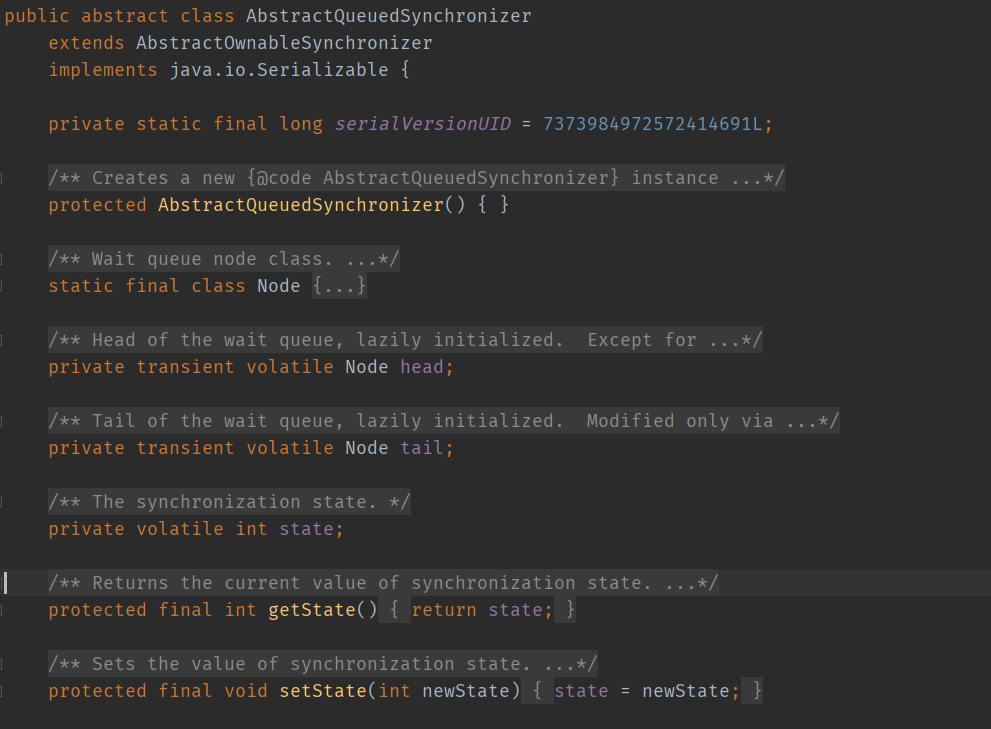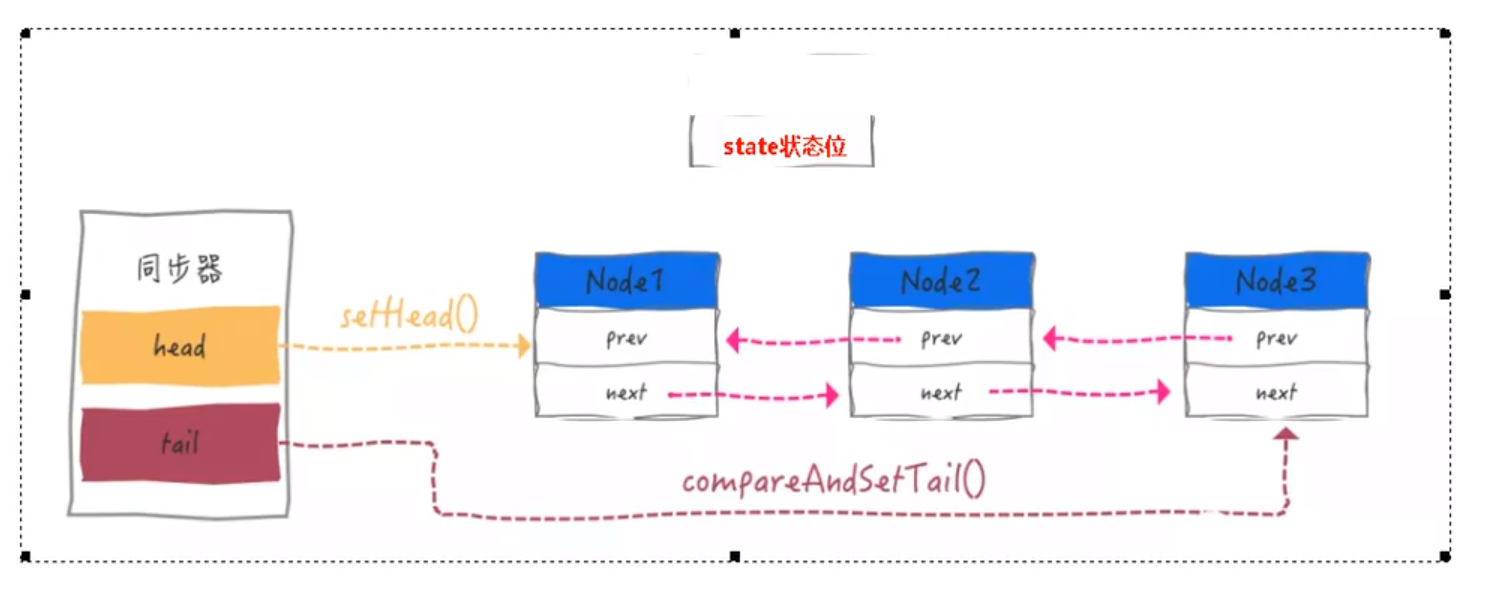您好,登錄后才能下訂單哦!
您好,登錄后才能下訂單哦!
本篇內容介紹了“如何理解AQS源碼”的有關知識,在實際案例的操作過程中,不少人都會遇到這樣的困境,接下來就讓小編帶領大家學習一下如何處理這些情況吧!希望大家仔細閱讀,能夠學有所成!
AQS abstractQueueSynchronizer(抽象隊列同步器),是什么?
答:它是用來構建鎖 或者 其他同步器組件的重量級基礎框架,是整個JUC體系的基礎。通過內置FIFO隊列來完成獲取線程取鎖的排隊工作,并通過一個int類型變量標識持有鎖的狀態;
前置知識點:
1、可重入鎖(遞歸鎖):
sync(隱式鎖,jvm管理)和ReentrantLock(Lock顯式鎖,就是手動加解)是重入鎖的典型代表,為可以重復使用的鎖。一個變成多個流程,可以獲取同一把鎖。
可重入鎖概念: 是指一個線程,在外層方法獲取鎖的時候,再次進入該線程的內層方法會自動獲取鎖(必須是同一個對象),不會被阻塞。可避免死鎖
舉例: 遞歸調用同一個 sync修飾的方法或者代碼塊。必須是一個對象才行。一個線程調用一個對象的method1,method1 調用method2,method2調用method3, 3個方法都是被sync修飾,這樣也是一個可重入鎖的例子 。
再比如下面這種
static Object lock = new Object();
public void mm(){
synchronized (lock){
System.out.println("===========mm method");
synchronized (lock){
System.out.println("=========== method");
}
}
}只有一個對象 和同步代碼塊,如果sycn中嵌套sync 并都是lock對象,那么該線程就會持有當前對象的鎖,并可重入。反編譯后發現
public void mm(); Code: 0: getstatic #7 // Field lock:Ljava/lang/Object; 3: dup 4: astore_1 5: monitorenter 6: getstatic #8 // Field java/lang/System.out:Ljava/io/PrintStream; 9: ldc #9 // String ===========mm method 11: invokevirtual #10 // Method java/io/PrintStream.println:(Ljava/lang/String;)V 14: aload_1 15: monitorexit 16: goto 24 19: astore_2 20: aload_1 21: monitorexit 22: aload_2 23: athrow 24: return Exception table: from to target type 6 16 19 any 19 22 19 any
sync同步代碼塊加解鎖,使用的命令為monitorenter 和 monitorexit(同步方法標識是ACC_SYNCHRONIZED,在flag中),enter 為加鎖,必須成對出現,但這里卻又兩個exit。原因為第一個exit為程序正常運行后的解鎖命令,并執行完后會執行goto到return ,也就是第24行,
第二個exit 為當程序出現異常時,需要執行的解鎖命令;
如上就是可重入鎖的相關概念
2、什么是LockSupport?
根據jdk8 的api文檔顯示定義為: 用于創建鎖和其他同步類的基本線程阻塞原語;
是一個線程阻塞工具類,所有方法均為靜態,可以讓線程在任意位置阻塞,阻塞后也有對應的喚醒方法。
先復習下object 對象的wait 和 notify 和Lock 的condition
wait 和notify 必須在sync 代碼塊中才能使用,否則報錯。非法的監視器
condition的await 和 signal方法也必須在lock 和unlock方法前執行,否則報錯,非法的監視器
線程一定要先 等待 ,再 被 喚醒,順序不能換
LockSupport 有兩個關鍵函數 park 和unpark,該類使用了Permit(許可證)的概念來阻塞和喚醒線程的功能。每個線程都會有一個Permit,該Permit 只有兩個值 0 和1 ,默認是0。類似于信號量,但上限是1;
來看park方法:
public static void park() {
//unsafe的方法。初始為0
UNSAFE.park(false, 0L);
}禁止當前線程進行線程調度,除非Permit可用,就是1
如果Permit 為1(有可用證書) 將變更為0(線程仍然會處理業務邏輯),并且立即返回。否則當前線程對于線程調度目的將被禁用,并處于休眠狀態。直至發生三件事情之一:
一些其他線程調用當前線程作為目標的unpark ; 要么
其他一些線程當前線程為interrupts ; 要么
電話虛假(也就是說,沒有理由)返回。
這種方法不報告是哪個線程導致該方法返回。 來電者應重新檢查導致線程首先停放的條件。 呼叫者還可以確定線程在返回時的中斷狀態。
小結:Permit默認0,所以一開始調用park,當前線程被阻塞,直到別的線程將當前線程的Permit修改為1,從park方法處被喚醒,處理業務,然后會將permit修改為0,并返回;如果permit為1,調用park時會將permit修改為0,在執行業務邏輯到線程生命周期。與park方法定義吻合。
在看unpark方法:
public static void unpark(Thread thread) {
if (thread != null)
UNSAFE.unpark(thread);
}在調用unpark方法后,會將Thread線程的許可permit設置成1,會自動喚醒thread線程,即,之前阻塞中的LockSupport.park方法會立即返回,然后線程執行業務邏輯 。 且 unpark可以在park之前執行。相當于執行park沒有效果。
3、AQS abstractQueueSynchronizer 源碼
剩余前置知識為: 公平鎖、非公平鎖、自旋鎖、鏈表、模板設計模式
AQS使用volatile修飾的int類型的變量 標識鎖的狀態,通過內置的FIFO隊列來完成資源獲取的排隊工作,將每條要去搶占資源的線程封裝成node節點實現鎖的分配,通過CAS(自旋鎖)完成對state值的修改 ;

(1)node節點源碼
static final class Node {
/** Marker to indicate a node is waiting in shared mode */
//共享節點
static final Node SHARED = new Node();
/** Marker to indicate a node is waiting in exclusive mode */
//獨占節點
static final Node EXCLUSIVE = null;
/** waitStatus value to indicate thread has cancelled */
//線程被取消狀態
static final int CANCELLED = 1;
/** waitStatus value to indicate successor's thread needs unparking */
// 后續線程需要喚醒
static final int SIGNAL = -1;
/** waitStatus value to indicate thread is waiting on condition */
//鄧丹condition喚醒
static final int CONDITION = -2;
/**
* waitStatus value to indicate the next acquireShared should
* unconditionally propagate
*/
//共享室同步狀態獲取 將會無條件傳播下去
static final int PROPAGATE = -3;
/**
* Status field, taking on only the values:
* SIGNAL: The successor of this node is (or will soon be)
* blocked (via park), so the current node must
* unpark its successor when it releases or
* cancels. To avoid races, acquire methods must
* first indicate they need a signal,
* then retry the atomic acquire, and then,
* on failure, block.
* CANCELLED: This node is cancelled due to timeout or interrupt.
* Nodes never leave this state. In particular,
* a thread with cancelled node never again blocks.
* CONDITION: This node is currently on a condition queue.
* It will not be used as a sync queue node
* until transferred, at which time the status
* will be set to 0. (Use of this value here has
* nothing to do with the other uses of the
* field, but simplifies mechanics.)
* PROPAGATE: A releaseShared should be propagated to other
* nodes. This is set (for head node only) in
* doReleaseShared to ensure propagation
* continues, even if other operations have
* since intervened.
* 0: None of the above
*
* The values are arranged numerically to simplify use.
* Non-negative values mean that a node doesn't need to
* signal. So, most code doesn't need to check for particular
* values, just for sign.
*
* The field is initialized to 0 for normal sync nodes, and
* CONDITION for condition nodes. It is modified using CAS
* (or when possible, unconditional volatile writes).
*/
//初始為0,狀態是上面幾種,標識當前節點在隊列中的狀態
volatile int waitStatus;
/**
* Link to predecessor node that current node/thread relies on
* for checking waitStatus. Assigned during enqueuing, and nulled
* out (for sake of GC) only upon dequeuing. Also, upon
* cancellation of a predecessor, we short-circuit while
* finding a non-cancelled one, which will always exist
* because the head node is never cancelled: A node becomes
* head only as a result of successful acquire. A
* cancelled thread never succeeds in acquiring, and a thread only
* cancels itself, not any other node.
*/
//前置節點
volatile Node prev;
/**
* Link to the successor node that the current node/thread
* unparks upon release. Assigned during enqueuing, adjusted
* when bypassing cancelled predecessors, and nulled out (for
* sake of GC) when dequeued. The enq operation does not
* assign next field of a predecessor until after attachment,
* so seeing a null next field does not necessarily mean that
* node is at end of queue. However, if a next field appears
* to be null, we can scan prev's from the tail to
* double-check. The next field of cancelled nodes is set to
* point to the node itself instead of null, to make life
* easier for isOnSyncQueue.
*/
//后置節點
volatile Node next;
/**
* The thread that enqueued this node. Initialized on
* construction and nulled out after use.
*/
//當線程對象
volatile Thread thread;
/**
* Link to next node waiting on condition, or the special
* value SHARED. Because condition queues are accessed only
* when holding in exclusive mode, we just need a simple
* linked queue to hold nodes while they are waiting on
* conditions. They are then transferred to the queue to
* re-acquire. And because conditions can only be exclusive,
* we save a field by using special value to indicate shared
* mode.
*/
Node nextWaiter;
/**
* Returns true if node is waiting in shared mode.
*/
final boolean isShared() {
return nextWaiter == SHARED;
}
/**
* Returns previous node, or throws NullPointerException if null.
* Use when predecessor cannot be null. The null check could
* be elided, but is present to help the VM.
*
* @return the predecessor of this node
*/
final Node predecessor() throws NullPointerException {
Node p = prev;
if (p == null)
throw new NullPointerException();
else
return p;
}node節點就是每一個等待執行的線程。還有一個waitState狀態字段,標識當前等待中的線程狀態
根據node節點 繪畫一個aqs基本結構圖

解釋:state為狀態位,aqs為同步器。有head 和tail兩個 頭 尾節點,當state = 1時,表明同步器被占用(或者說當前有線程持有了同一個對象的鎖),將后續線程添加到隊列中,并用雙向鏈表連接,遵循FIFO。
(2)以ReentrantLock的實現分析。因為他也實現了Lock 并內部持有同步器sync和AQS(以銀行柜臺例子)
new ReentrantLock()或 new ReentrantLock(false)時,創建的是非公平鎖,而 ReentrantLock對象內部還有 兩個類 分別為公平同步器和非公平同步器
static final class NonfairSync extends Sync //公平鎖 有一個判斷隊列中是否有排隊的線程,這是與上面鎖不同的獲取方式 static final class FairSync extends Sync
公平鎖解釋:先到先得,新線程在獲取鎖時,如果這個同步器的等待隊列中已經有線程在等待,那么當前線程會先進入等待隊列;
非公平鎖解釋:新進來的線程不管是否有等待的線程,如果可以獲取鎖,則立刻占有鎖。
這里還有一個關鍵的模板設計模式: 在查詢aqs的tryAcquire方法時發現,該方法直接拋出異常,這就是典型的模板設計模式,強制要求子類重寫該方法。否則不讓用
1.1 當線程a到柜臺辦理業務時,會調用sync 的lock,即 a線程調用lock方法
final void lock() {
//利用cas將當前對象的state 從0 設置成1,當然里面還有一個偏移量
//意思就是如果是0 就設置為1成功返回true
if (compareAndSetState(0, 1))
setExclusiveOwnerThread(Thread.currentThread());
else
acquire(1);
}因為是第一個運行的線程,肯定是true所以,將當前運行的線程設置為a,即a線程占用了同步器,獲取了鎖
1.2 當b線程運行lock時,發現不能將0設置成1(cas思想),就會運行acquire(1)方法
public final void acquire(int arg) {
//這里用到了模板設計模式,強制子類實現該方法
//因為默認使用非公平鎖,所以看NonfairSync
if (!tryAcquire(arg) &&
acquireQueued(addWaiter(Node.EXCLUSIVE), arg))
selfInterrupt();
}
static final class NonfairSync extends Sync {
private static final long serialVersionUID = 7316153563782823691L;
/**
* Performs lock. Try immediate barge, backing up to normal
* acquire on failure.
*/
final void lock() {
if (compareAndSetState(0, 1))
setExclusiveOwnerThread(Thread.currentThread());
else
acquire(1);
}
protected final boolean tryAcquire(int acquires) {
return nonfairTryAcquire(acquires);
}
}
//該方法就是非公平鎖執行 等待的方法
final boolean nonfairTryAcquire(int acquires) {
//獲取當前b線程
final Thread current = Thread.currentThread();
//獲取當前鎖的狀態是1,因為a線程已經獲取,并將state修改為1
int c = getState();
//有可能b在設置state時,a正辦理,到這兒時,a辦理完了。state為0了。
if (c == 0) {
//樂觀的將state 從0 修改為 1
if (compareAndSetState(0, acquires)) {
//設置當前獲取鎖的線程為b
setExclusiveOwnerThread(current);
return true;
}
}
//有可能 a線程辦完業務。又回頭辦理了一個,所以當前線程持有鎖的線程依舊是a
else if (current == getExclusiveOwnerThread()) {
//2
int nextc = c + acquires;
if (nextc < 0) // overflow
throw new Error("Maximum lock count exceeded");
//設置state的值
setState(nextc);
return true;
}
//如果b線程走到這里,就證明b必須到等待隊列里去了
return false;
}再來看邏輯運算符后面的邏輯
private Node addWaiter(Node mode) {
//實例化一個節點,并將b 和 節點類型封裝成node
Node node = new Node(Thread.currentThread(), mode);
//等待隊列為null 所以tail初始化肯定是null
//如果是線程c在b之后進來,tail就是b 節點
Node pred = tail;
//c節點之后都走這個方法
if (pred != null) {
//node的前置為tail
//c 的前置設置為b
node.prev = pred;
//cas樂觀,比較 如果當前節點仍然是b 就將b 設置成c
//b就是tail尾節點,將tail設置成c
//這里根據源碼可知,就是將tail的值設置成c 并不影響pred的值,還是b
if (compareAndSetTail(pred, node)) {
//b 的下一個節點設置成c
pred.next = node;
return node;
}
}
//線程b 入等待隊列
enq(node);
return node;
}
//入隊列方法
private Node enq(final Node node) {
//該方法類似于while(true)
for (;;) {
//獲取tail節點
Node t = tail;
//初始化鎖等待隊列
if (t == null) { // Must initialize
//設置頭部節點為新的節點
//這里看出,鎖等待隊列的第一個節點并非b,而是一個空node,該node為站位節點或者叫哨兵節點
if (compareAndSetHead(new Node()))
//將頭尾都指向該節點
tail = head;
} else {
//第二次循環時,t為空node,將b的前置設置為空node
node.prev = t;
//設置tail節點為b節點
if (compareAndSetTail(t, node)) {
//空node節點的下一個節點為b node節點
t.next = node;
return t;
}
}
}
}
/**
* CAS head field. Used only by enq.
*/
private final boolean compareAndSetHead(Node update) {
return unsafe.compareAndSwapObject(this, headOffset, null, update);
}以上b線程的進入等待隊列的操作就完成了 ,但線程還是活躍的,如何阻塞的呢?
下面接著看acquireQueued方法
final boolean acquireQueued(final Node node, int arg) {
boolean failed = true;
try {
boolean interrupted = false;
//自旋執行
for (;;) {
//如果是b線程,這里p就是b節點的前置節點
final Node p = node.predecessor();
//空節點就是head節點,但又調用了一次tryAcquire方法,想再嘗試獲取鎖資源
//如果a線程未處理完,那么這里返回false
//如果a線程處理完成,那么這里就可以獲取到鎖
if (p == head && tryAcquire(arg)) {
//將head設置成b節點
setHead(node);
//原空節點的下連接斷開
p.next = null; // help GC
failed = false;
return interrupted;
}
//第一次空節點進入should方法。返回false
//當第二次循環到此處should方法返回true
//執行parkAndCheckInterrupt方法,會將當前線程park,并獲取b線程的中斷狀態,如果未中斷返回false,并再次自旋一次 ,中斷為true
if (shouldParkAfterFailedAcquire(p, node) &&
parkAndCheckInterrupt())
interrupted = true;
}
} finally {
if (failed)
cancelAcquire(node);
}
}
private static boolean shouldParkAfterFailedAcquire(Node pred, Node node) {
//head節點就是空節點所以w=0
//空節點第二次進入時就是-1
int ws = pred.waitStatus;
if (ws == Node.SIGNAL)
return true;
//如果b節點狀態是其他,則將節點連接變化一下
if (ws > 0) {
do {
node.prev = pred = pred.prev;
} while (pred.waitStatus > 0);
pred.next = node;
} else {
//ws = 0時,使用cas將驗證pred 和ws 的值,是空節點和0 并將ws修改為-1
compareAndSetWaitStatus(pred, ws, Node.SIGNAL);
}
return false;
}
private final boolean parkAndCheckInterrupt() {
LockSupport.park(this);
return Thread.interrupted();
}以上b線程未獲取鎖 并被掛起的操作就完成了
1.3 當a線程調用unlock方法時:
public void unlock() {
sync.release(1);
}
public final boolean release(int arg) {
//判斷a線程是否完成業務。并釋放鎖,state=0
if (tryRelease(arg)) {
//獲取頭部節點,就是空節點
Node h = head;
//空節點在b獲取鎖時,狀態變更為-1,所以這里是true
if (h != null && h.waitStatus != 0)
//喚醒線程
unparkSuccessor(h);
return true;
}
return false;
}
//aqs父類的模板方法,強制要求子類實現該方法
protected boolean tryRelease(int arg) {
throw new UnsupportedOperationException();
}
protected final boolean tryRelease(int releases) {
//將鎖的狀態設置為0
int c = getState() - releases;
//判斷當前線程與 鎖的獨占線程是否一致
if (Thread.currentThread() != getExclusiveOwnerThread())
throw new IllegalMonitorStateException();
//所得狀態標識
boolean free = false;
if (c == 0) {
free = true;
//如果state=0證明a完成了業務。那么鎖的獨占狀態就應該恢復為null
setExclusiveOwnerThread(null);
}
//恢復鎖的state狀態
setState(c);
return free;
}注意:這里state是減1操作。如果ReentrantLock不斷可重入,那么這里是不能一次就歸零的。所以才會有ReentrantLock 調了幾次lock 就是要調幾次unlock
a線程喚醒b線程
private void unparkSuccessor(Node node) {
int ws = node.waitStatus;
if (ws < 0)
//空節點-1,設置成0
compareAndSetWaitStatus(node, ws, 0);
//獲取b節點,非null 且 waitState=0
Node s = node.next;
if (s == null || s.waitStatus > 0) {
s = null;
for (Node t = tail; t != null && t != node; t = t.prev)
if (t.waitStatus <= 0)
s = t;
}
if (s != null)
//將b線程喚醒
LockSupport.unpark(s.thread);
}而 b線程還在acquireQueued方法里自旋呢,不過自旋后就會獲取鎖。
final boolean acquireQueued(final Node node, int arg) {
boolean failed = true;
try {
boolean interrupted = false;
//b線程在a未釋放鎖之前一直在自旋,
for (;;) {
final Node p = node.predecessor();
//當a釋放鎖后,b獲取到鎖,將state設置為1
//并將空節點的所有連接斷開等待GC回收
//并返回當前線程 b 的中斷狀態
if (p == head && tryAcquire(arg)) {
setHead(node);
p.next = null; // help GC
failed = false;
return interrupted;
}
if (shouldParkAfterFailedAcquire(p, node) &&
//park當前線程b 并獲取b的中斷狀態,肯定是false,且調用的是帶參的native方法,多次調用會重置b線程的中斷狀態
parkAndCheckInterrupt())
interrupted = true;
}
} finally {
if (failed)
cancelAcquire(node);
}
}
//調用該方法的if判斷如果進入了。會將b 中斷,并在不斷循環中再重置中斷狀態為false1.4 c線程的執行流程與b線程類似。會將b節點充等待隊列中移除,遵循FIFO
“如何理解AQS源碼”的內容就介紹到這里了,感謝大家的閱讀。如果想了解更多行業相關的知識可以關注億速云網站,小編將為大家輸出更多高質量的實用文章!
免責聲明:本站發布的內容(圖片、視頻和文字)以原創、轉載和分享為主,文章觀點不代表本網站立場,如果涉及侵權請聯系站長郵箱:is@yisu.com進行舉報,并提供相關證據,一經查實,將立刻刪除涉嫌侵權內容。